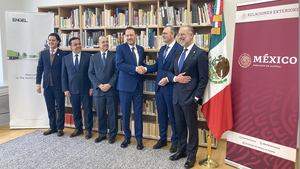April 4, 2017

 When talk turns to the fate of the North American Free Trade Agreement (NAFTA) under a Trump administration, the focus tends to be on the automotive and appliances markets. A recent article published on March 31 in the New York Times, “Also Made in Mexico: Lifesaving Medical Devices,” draws attention to a sector that is usually not part of that conversation, but it should be.
When talk turns to the fate of the North American Free Trade Agreement (NAFTA) under a Trump administration, the focus tends to be on the automotive and appliances markets. A recent article published on March 31 in the New York Times, “Also Made in Mexico: Lifesaving Medical Devices,” draws attention to a sector that is usually not part of that conversation, but it should be.
Mexico has quietly built medical manufacturing hubs in Baja Mexico, especially in the greater Tijuana area, as well as in and around the cities of Jalisco, Nuevo Leon, Chihuahua, Tamaulipas, Coahuila and Sonora. In 2015, the Paso del Norte Biomedical Cluster was formed to capitalize on the cross-border medical and manufacturing expertise in the region around Juarez; El Paso, TX; and southern New Mexico.
In June 2016, PlasticsToday reported that Mexico’s medical devices market was set to grow from $4.9 billion in 2015 to $6.5 billion by 2020, according to analysis from GlobalData (London). The United States imports about 30% of its medical devices and associated parts, writes the New York Times, and Mexico is the leading supplier, ahead of Ireland, Germany and China. “Nearly everyone in America who has a pacemaker . . . walks around with parts from [Mexico],” writes Sarah Varney in the Times. A plethora of medical plastic disposables, such as catheters, also come by the truckloads from south of the border. So it’s no surprise that Trump’s protectionist tendencies and threats to impose a border tax have rattled even Tijuana’s “unflappable longtime entrepreneurs,” writes Varney, but it also keeps medtech executives in the United States up at night.
“American companies draft plans to build new plants—or expand existing ones—years in advance,” Miguel Felix Diaz, Vice President of the Baja California Medical Device Cluster, told Varney. “For that reason now, you don’t know if you start some operation tomorrow how it’s going to be affected.” It’s also worth noting that FDA inspects and registers medical device manufacturers both in the United States and around the world, a process that can take many months. Changing locations or even switching suppliers is not something you can do on a whim in such a heavily regulated industry.
BIOMEDevice Boston, in partnership with the Massachusetts Medical Device Industry Council (MassMEDIC), comes to the Boston Convention & Exhibition Center on May 3 and 4. Join more than 4000 engineers, executives and suppliers at this event showcasing the full spectrum of medical product design and manufacturing solutions. Go to the event website for more information and to register to attend. |
Whether a border tax is successful in luring manufacturers back to the United States or if they decide to stay put and jack up the cost of products made in Mexico, consumers of medical technology will pay the price. “Technicians at medical device factories in Tijuana earn about $14 an hour, compared with about $25 an hour for technicians at factories in the United States,” notes Varney. Do the math.
The article also points to unintended “ricochet” effects that a border tax would have across the U.S.-Mexico border and around the world.
Mexico’s medtech industry buys much of its raw materials and capital machinery from U.S. suppliers, writes Varney, citing the example of Integer, a U.S.-owned plant in Tijuana. Integer buys 90% of its raw materials from the United States: “Stainless steel to be stamped into cups used for hip replacements and plastic to be molded into catheters. Then half of the factory’s output is shipped back to the United States and much of the rest to American-owned companies in Puerto Rico, Switzerland and Singapore,” writes Varney. If the United States were to impose a border tax, Mexico, in all likelihood, would apply tariffs on incoming raw materials. “Production costs would spike for companies in Mexico, or those companies would shift to suppliers in other countries eager to cut low-tariff deals like China,” writes Varney. “The damage wouldn’t just to be to the Mexico operation, it would be to U.S. suppliers,” said Christopher Wilson, Deputy Director of the Mexico Institute at the Woodrow Wilson International Center for Scholars.
Yeah, who knew reconfiguring international trade agreements could be so complicated?
About the Author(s)
You May Also Like




